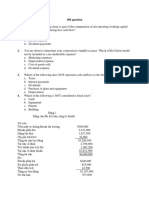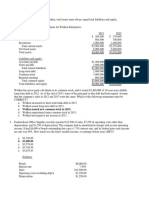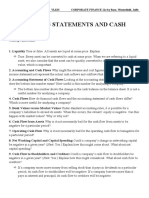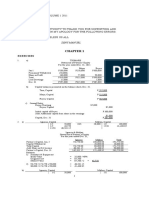2011-02-09 035108 Finance 14
2011-02-09 035108 Finance 14
Uploaded by
SamCopyright:
Available Formats
2011-02-09 035108 Finance 14
2011-02-09 035108 Finance 14
Uploaded by
SamOriginal Title
Copyright
Available Formats
Share this document
Did you find this document useful?
Is this content inappropriate?
Copyright:
Available Formats
2011-02-09 035108 Finance 14
2011-02-09 035108 Finance 14
Uploaded by
SamCopyright:
Available Formats
Chapter 14 Problems
1. Baxter Video Products’ sales are expected to increase from $5 million in 2007 to $6
million in 2008 or by 20%. Its assets totaled $3 million at the end of 2007. Baxter is at
full capacity, so its assets must grow at the same rate as projected sales. At the end of
2007, current liabilities were $1 million, consisting of $250,000 of accounts payable,
$500,000 of notes payable, and $250,000 of accruals. The after-tax profit margin is
forecasted to be 5%, and the forecasted payout ratio is 70%. Use the AFN formula to
forecast Baxter’s additional funds needed for the coming year.
AFN = (A*/S0)∆S - (L*/S0)∆S - MS1(1 - d)
$3,000,000 $500,000
= $1,000,000 - $1,000,000 - 0.05($6,000,000)(1 - 0.7)
$5,000,000 $5,000,000
= (0.6)($1,000,000) - (0.1)($1,000,000) - ($300,000)(0.3)
= $600,000 - $100,000 - $90,000
= $410,000.
4. Bannister Legal Services generated $2.0 million in sales during 2007, and its yearend
total assets were $1.5 million. Also, at year-end 2007, current liabilities were $500,000,
consisting of $200,000 of notes payable, $200,000 of accounts payable, and $100,000 of
accruals. Looking ahead to 2008, the company estimates that its assets must increase by
75 cents for every $1 increase in sales. Bannister’s profit margin is 5%, and its payout
ratio is 60%. How large a sales increase can the company achieve without having to raise
funds externally?
S2007 = $2,000,000; A2007 = $1,500,000; CL2007 = $500,000;
NP2007 = $200,000; A/P2007 = $200,000; Accruals2007 = $100,000;
PM = 5%; d = 60%; A*/S0 = 0.75.
AFN = (A*/S0)∆S - (L*/S0)∆S - MS1(1 - d)
$300,000
= (0.75)∆S - ∆S -(0.05)(S1)(1 - 0.6)
$2,000,000
= (0.75)∆S - (0.15)∆S - (0.02)S1
= (0.6)∆S - (0.02)S1
= 0.6(S1 - S0) - (0.02)S1
= 0.6(S1 - $2,000,000) - (0.02)S1
= 0.6S1 - $1,200,000 - 0.02S1
$1,200,000 = 0.58S1
$2,068,965.52 = S1.
Sales can increase by $2,068,965.52 - $2,000,000 = $68,965.52 without additional
funds being needed.
5. At year-end 2007, total assets for Bertin Inc. were $1.2 million and accounts payable
were $375,000. Sales, which in 2007 were $2.5 million, are expected to increase by 25%
in 2008. Total assets and accounts payable are proportional to sales, and that relationship
will be maintained. Bertin typically uses no current liabilities other than accounts
payable. Common stock amounted to $425,000 in 2007, and retained earnings were
$295,000. Bertin plans to sell new common stock in the amount of $75,000. The firm’s
profit margin on sales is 6%; 40% of earnings will be paid out as dividends.
a. What was Bertin’s total debt in 2007?
b. How much new, long-term debt financing will be needed in 2008? (Hint:
AFN _ New stock _ New long-term debt.) Do not consider any financing feedback effects
Total liabilities Accounts Long - term Common Retained
a. .
and equity Payable debt stock earnings
$1,200,000 = $375,000 + Long-term debt + $425,000 + $295,000
Long-term debt = $105,000.
Total debt = Accounts payable + Long-term debt
= $375,000 + $105,000 = $480,000.
Alternatively,
Total
Total debt = liabilities - Common stock - Retained earnings
and equity
= $1,200,000 - $425,000 - $295,000 = $480,000.
b. Assets/Sales (A*/S) = $1,200,000/$2,500,000 = 48%.
L*/Sales = $375,000/$2,500,000 = 15%.
2006 Sales = (1.25)($2,500,000) = $3,125,000.
AFN = (A*/S)(∆S) - (L*/S)(∆S) - MS1(1 - d) - New common stock
= (0.48)($625,000) - (0.15)($625,000) - (0.06)($3,125,000)(0.6) - $75,000
= $300,000 - $93,750 - $112,500 - $75,000 = $18,750.
Alternatively, using the percentage of sales method:
Forecast
Basis % Additions (New
2007 2008 Sales Financing, R/E) Pro
Forma
Total assets $1,200,000 0.48
$1,500,000
Current liabilities $ 375,000 0.15 $ 468,750
Long-term debt 105,000 105,000
Total debt $ 480,000 $ 573,750
Common stock 425,000 75,000* 500,000
Retained earnings 295,000 112,500** 407,500
Total common equity $ 720,000 $ 907,500
Total liabilities
and equity $1,200,000
$1,481,250
AFN = Long-term debt = $ 18,750
*Given in problem that firm will sell new common stock = $75,000.
**PM = 6%; Payout = 40%; NI2008 = $2,500,000 x 1.25 x 0.06 = $187,500.
Addition to RE = NI x (1 - Payout) = $187,500 x 0.6 = $112,500
6. The Booth Company’s sales are forecasted to increase from $1,000 in 2007 to $2,000
in 2008. Here is the December 31, 2007, balance sheet:
Cash $100 Accounts payable $50
Accounts receivable $200 Notes payable $150
Inventories $200 Accruals $50
Net fixed assets $500 Long-term debt $400
Common stock $100
Retained earnings $250
Total assets $1,000 Total liabilities and equity $1,000
Booth’s fixed assets were used to only 50% of capacity during 2007, but its current assets
were at their proper levels. All assets except fixed assets increase at the same rate as
sales, and fixed assets would also increase at the same rate if the current excess capacity
did not exist. Booth’s after-tax profit margin is forecasted to be 5%, and its payout ratio
will be 60%. What is Booth’s additional funds needed (AFN) for the coming year?
Cash $ 100.00 2 = $ 200.00
Accounts receivable 200.00 2 = 400.00
Inventories 200.00 2 = 400.00
Net fixed assets 500.00 + 0.0 = 500.00
Total assets $1,000.00 $1,500.00
Accounts payable $ 50.00 2 = $ 100.00
Notes payable 150.00 150.00 + 360.00 = 510.00
Accruals 50.00 2 = 1 00.00
Long-term debt 400.00 400.00
Common stock 100.00 100.00
Retained earnings 250.00 + 40 = 290.00
Total liabilities
and equity $1,000.00 $1,140.00
AFN $ 360.00
Capacity sales = Sales/0.5 = $1,000/0.5 = $2,000.
Target FA/S ratio = $500/$2,000 = 0.25.
Target FA = 0.25($2,000) = $500 = Required FA. Since the firm currently has
$500 of fixed assets, no new fixed assets will be required.
Addition to RE = M(S1)(1 - Payout ratio) = 0.05($2,000)(0.4) = $40.
You might also like
- CFI - FMVA Practice Exam Case Study ADocument18 pagesCFI - FMVA Practice Exam Case Study AWerfelli MaramNo ratings yet
- AC517Document11 pagesAC517Inaia ScottNo ratings yet
- M3 Activity 1Document6 pagesM3 Activity 1Ruffa May Gonzales100% (1)
- HW 1-SolnDocument8 pagesHW 1-SolnZhaohui ChenNo ratings yet
- Case 7 - An Introduction To Debt Policy and ValueDocument5 pagesCase 7 - An Introduction To Debt Policy and ValueAnthony Kwo100% (2)
- FM AssignmentDocument4 pagesFM AssignmentDuren JayaNo ratings yet
- ACCT4110 Advanced Accounting PRACTICE Exam 2 KEY v2Document14 pagesACCT4110 Advanced Accounting PRACTICE Exam 2 KEY v2accounts 3 lifeNo ratings yet
- Financial Planning and Forecasting Brigham SolutionDocument29 pagesFinancial Planning and Forecasting Brigham SolutionShahid Mehmood100% (6)
- Globe PLDT 2014 Financial RatiosDocument6 pagesGlobe PLDT 2014 Financial RatiosSamNo ratings yet
- 17Document4 pages17Serene Nicole Villena60% (5)
- Value Chain Management Capability A Complete Guide - 2020 EditionFrom EverandValue Chain Management Capability A Complete Guide - 2020 EditionNo ratings yet
- Cost Of Capital A Complete Guide - 2020 EditionFrom EverandCost Of Capital A Complete Guide - 2020 EditionRating: 4 out of 5 stars4/5 (1)
- FM12 CH 14 Solutions ManualDocument21 pagesFM12 CH 14 Solutions ManualRizwanasaleemNo ratings yet
- Solutions Nss NC 17Document13 pagesSolutions Nss NC 17lethiphuongdan50% (2)
- 2.0 FIN Plan & Forecasting v1Document62 pages2.0 FIN Plan & Forecasting v1Omer CrestianiNo ratings yet
- Financial Forecasting SamarakoonDocument33 pagesFinancial Forecasting SamarakoonEyael ShimleasNo ratings yet
- Tugas Minggu Ke 5Document4 pagesTugas Minggu Ke 5Devenda Kartika RoffandiNo ratings yet
- Financial Planning and Forecasting - Solved Q&ADocument6 pagesFinancial Planning and Forecasting - Solved Q&ARex CalibreNo ratings yet
- Chapter 2 - Solved ProblemDocument8 pagesChapter 2 - Solved Problemhikari.5e4No ratings yet
- A.2. Liabilities and Equity EssayDocument5 pagesA.2. Liabilities and Equity EssayKondreddi SakuNo ratings yet
- Assignment 3 SolutionDocument7 pagesAssignment 3 SolutionAaryaAustNo ratings yet
- Practice Quesions Fin Planning ForecastingDocument19 pagesPractice Quesions Fin Planning ForecastingAli HussainNo ratings yet
- Financial Planning and Forecasting Financial Statements: Answers To End-Of-Chapter QuestionsDocument9 pagesFinancial Planning and Forecasting Financial Statements: Answers To End-Of-Chapter QuestionsArpit BhawsarNo ratings yet
- Question - FS and FADocument6 pagesQuestion - FS and FANguyễn Thùy LinhNo ratings yet
- Accounting and Finance Tugas Kelompok #3 Chapter 6 Financial Planning and ForecastingDocument10 pagesAccounting and Finance Tugas Kelompok #3 Chapter 6 Financial Planning and Forecastingbudiman100% (1)
- Question - BS and FADocument6 pagesQuestion - BS and FANguyễn Thùy LinhNo ratings yet
- Tugas Kelompok 1Document6 pagesTugas Kelompok 1Bought By UsNo ratings yet
- Problems On Analysis of Financial StatementsDocument6 pagesProblems On Analysis of Financial StatementsKim DavilloNo ratings yet
- Purchase Price and Implied Value Less: Book Value of Equity Acquired: Difference Beetwen Implied and Book Value Record New Goodwil BalanceDocument14 pagesPurchase Price and Implied Value Less: Book Value of Equity Acquired: Difference Beetwen Implied and Book Value Record New Goodwil BalancesallyNo ratings yet
- Financial Planning and Forecasting Pro Forma Financial StatementsDocument22 pagesFinancial Planning and Forecasting Pro Forma Financial StatementsCOLONEL ZIKRIA0% (1)
- Financial Planning and Forecasting Financial Statements: Answers To End-Of-Chapter QuestionsDocument10 pagesFinancial Planning and Forecasting Financial Statements: Answers To End-Of-Chapter QuestionsBilal RazzaqNo ratings yet
- Week 2-6 CFM SolutionsDocument32 pagesWeek 2-6 CFM SolutionsRalph MarquetaNo ratings yet
- Name: Curie Falentina Pandiangan Class: International MBA - 10 NIM: 20/465214/PEK/26217 Financial Management AssignmentsDocument4 pagesName: Curie Falentina Pandiangan Class: International MBA - 10 NIM: 20/465214/PEK/26217 Financial Management AssignmentsDuren JayaNo ratings yet
- Final RevisionDocument13 pagesFinal Revisionaabdelnasser014No ratings yet
- Topik 4 - Fin Planning & ForecastingDocument24 pagesTopik 4 - Fin Planning & ForecastingHaryadi WidodoNo ratings yet
- Chapter 8 ExercisesDocument4 pagesChapter 8 ExercisesZiaNo ratings yet
- (TUBONG) Module 3 - Activity 1Document9 pages(TUBONG) Module 3 - Activity 1CristopherNo ratings yet
- Financial ManagementDocument12 pagesFinancial ManagementValeria MartinezNo ratings yet
- 1130 - 89 - Tugas Pribadi Akl Pertemuan 9 Dan 11Document9 pages1130 - 89 - Tugas Pribadi Akl Pertemuan 9 Dan 11Maulana AmriNo ratings yet
- FIN101 Principles of FinanceDocument6 pagesFIN101 Principles of FinanceIshrat KhanNo ratings yet
- Name: Nurul Sari NIM: 1101002048 Case 7.1 7.2 7.7: Case 7.1: Investment Center Problems (A)Document4 pagesName: Nurul Sari NIM: 1101002048 Case 7.1 7.2 7.7: Case 7.1: Investment Center Problems (A)Eigha apriliaNo ratings yet
- Solutions To End-Of-Chapter ProblemsDocument4 pagesSolutions To End-Of-Chapter ProblemsRab RakhaNo ratings yet
- Dwi Suci Indah S - 472026 - W5 Easy ProblemDocument5 pagesDwi Suci Indah S - 472026 - W5 Easy ProblemucyNo ratings yet
- Complete Chapter 2 Problem, 2-8, P. 79: Calculation Is Based On A 365-Day YearDocument2 pagesComplete Chapter 2 Problem, 2-8, P. 79: Calculation Is Based On A 365-Day YearJennifer Kershaw100% (1)
- TM 10 - Financial Planning and ForecastingDocument29 pagesTM 10 - Financial Planning and ForecastingTul KuntullNo ratings yet
- Fin 101Document5 pagesFin 101Ishrat KhanNo ratings yet
- C. Wolken Issued New Common Stock in 2013Document4 pagesC. Wolken Issued New Common Stock in 2013Talha JavedNo ratings yet
- Chapter 2Document3 pagesChapter 2Ikramul HaqueNo ratings yet
- CH 2 SolutionDocument7 pagesCH 2 SolutionJohnNo ratings yet
- Foundations of Financial Management: Spreadsheet TemplatesDocument7 pagesFoundations of Financial Management: Spreadsheet Templatesalaa_h1100% (1)
- MBA CorporateDocument4 pagesMBA CorporateJohn BiliNo ratings yet
- Solution - Problems and Solutions Chap 3Document4 pagesSolution - Problems and Solutions Chap 3Ajeet YadavNo ratings yet
- MBA 570 Min Case CHP 14 WK 2Document11 pagesMBA 570 Min Case CHP 14 WK 2chastityc2001No ratings yet
- Chapter 2 Financial Statements Cash Flow and TaxesDocument7 pagesChapter 2 Financial Statements Cash Flow and TaxesM. HasanNo ratings yet
- Chapter 2 - Concept Questions and Exercises StudentDocument9 pagesChapter 2 - Concept Questions and Exercises StudentVõ Lê Khánh HuyềnNo ratings yet
- Solution Manual For Corporate Finance Canadian 7th Edition by Ross Westerfield Jaffe Robertsl ISBN 0071339574 9780071339575Document36 pagesSolution Manual For Corporate Finance Canadian 7th Edition by Ross Westerfield Jaffe Robertsl ISBN 0071339574 9780071339575stephanievargasogimkdbxwn100% (32)
- Capital Structure ProblemsDocument6 pagesCapital Structure Problemschandel08No ratings yet
- Advanced Entrepreneurial Finance ExerciseDocument3 pagesAdvanced Entrepreneurial Finance Exercisesidi abdellahiNo ratings yet
- Visual Financial Accounting for You: Greatly Modified Chess Positions as Financial and Accounting ConceptsFrom EverandVisual Financial Accounting for You: Greatly Modified Chess Positions as Financial and Accounting ConceptsNo ratings yet
- Concept Map Part FormationDocument4 pagesConcept Map Part FormationSamNo ratings yet
- 6a Pred Working Cap MGT 2Document9 pages6a Pred Working Cap MGT 2SamNo ratings yet
- 5 Min SpeechDocument2 pages5 Min SpeechSamNo ratings yet
- CSR RoadmapDocument1 pageCSR RoadmapSamNo ratings yet
- AA Chapter1Document5 pagesAA Chapter1Marc Jim GregorioNo ratings yet
- Toa Interim ReportingDocument17 pagesToa Interim ReportingSam100% (1)
- Title PageDocument1 pageTitle PageSamNo ratings yet
- mgm4137 1328501852Document37 pagesmgm4137 1328501852Sam50% (4)





































































